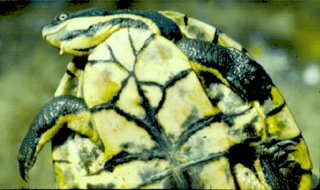
Pelochelys is a genus of very large softshell turtles in the family Trionychidae. They are found from peninsular India northeast to southern China, and south to Southeast Asia and New Guinea.

The Chinese softshell turtle is a species of softshell turtle that is native to China and Taiwan, with records of escapees—some of which have established introduced populations—in a wide range of other Asian countries, as well as Spain, Brazil and Hawaii.

Trionychia is a superfamily of turtles which encompasses the species that are commonly referred to as softshelled turtles as well as some others. The group contains two families, Carettochelyidae, which has only one living species, the pig-nosed turtle native to New Guinea and Northern Australia, and Trionychidae, the softshelled turtles, containing numerous species native to Asia, North America and Africa. These families likely diverged during the late Jurassic. The oldest known stem-trionychian is Sinaspideretes from the Late Jurassic of China.

The Mexican box turtle is a species of box turtle belonging to the family Emydidae. It is sometimes treated as a subspecies of Terrapene carolina.

Chelus is a genus of large freshwater turtles found in tropical South America. Formerly considered to be a monotypic genus, it now consists of two species after Chelus orinocensis was identified in 2020 from a genetic analysis.

Amyda is a genus of softshell turtles in the family Trionychidae. It contains two extant species:

The Cuatro Ciénegas softshell, also called the black spiny softshell, is a subspecies of the spiny softshell turtle in the family Trionychidae. It is found only in the Cuatro Ciénegas Basin in the Mexican state of Coahuila and it is considered critically endangered by the IUCN. The subspecies, along with its parent species, was formerly classified in the genus Trionyx.

Cyclanorbis is a genus of softshell turtles in the family Trionychidae. The genus is endemic to Africa.

The New Guinea snake-necked turtle is a species of turtle in the family Chelidae. The species is found almost exclusively within Western Province, Papua New Guinea.

The Western New Guinea stream turtle or New Guinea snapping turtle is a species of freshwater turtle in the Chelidae family. It is found in the Bird's Head Peninsula and the Bomberai Peninsula west of Cenderawasih Bay, and on the island of Waigeo of West Papua, Indonesia.

The Manning River snapping turtle is a species of turtle in the family Chelidae, endemic to Australia.

The Yucatán box turtle is a species of box turtle endemic to Mexico. It is sometimes treated as a subspecies of Terrapene carolina.

Pelodiscus is a genus of turtles in the family Trionychidae, the softshells. Based on genetic and morphological analysis there are seven valid species. They are native to Eastern Asia, ranging from the Amur region, south through China and Korea, as far south as Vietnam. Populations in Japan are thought to likely originate from historic human introductions.

The furrowed wood turtle is a species of turtle belonging to the genus Rhinoclemmys of the family Geoemydidae found in the Yucatán Peninsula and adjacent regions of Central America.
The Maracaibo wood turtle is a species of turtles in the family Geoemydidae. The species is endemic to northern South America.
The northern New Guinea giant softshell turtle is a species of turtle found in the lowlands of northern New Guinea. South of the Central Range it is replaced by the closely related southern New Guinea giant softshell turtle. It is threatened by overhunting and harvesting of eggs as well as significant habitat loss of aquatic vegetation due to introduced fish species such as the red-bellied pacu.

Pelodiscus maackii, commonly known as the Amur softshell turtle or the northern Chinese softshell turtle, is a species of turtle in the family Trionychidae. The species is found in the Russian Far East, northeastern China, Korea, and Japan. It is possible that the Japanese populations are the result of ancient introductions by humans. This aquatic species may attain a straight carapace length of 32.5 cm (1.1 ft).
The lesser Chinese softshell turtle is a species of turtle in the family Trionychidae. It is endemic to China, where it inhabits a small range in Guangxi and Hunan provinces. Populations of this species in Vietnam and Hainan are now considered to belong to a separate species, the spotted softshell turtle.

The spotted softshell turtle is a species of turtle in the family Trionychidae. It is found in Indochina, where it is largely restricted to most of Vietnam; isolated populations belonging to Pelodiscus have been discovered in Hainan Island, some of which are considered spotted softshell turtles. Aside from genetic differences, this species can be most readily distinguished from other Pelodiscus by the large blotches on its plastron, which also gave it its name. Due to its restricted geographic range and the heavy level of exploitation it receives, it has been proposed that this species be classified as Critically Endangered under the IUCN Red List.
The Huangshan softshell turtle or horse-hoof softshell turtle is a species of turtle in the family Trionychidae. It is endemic to China, where it is found only in southern Anhui Province, in the Huangshan range.
















